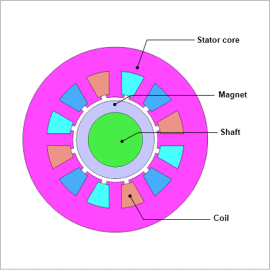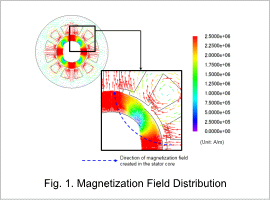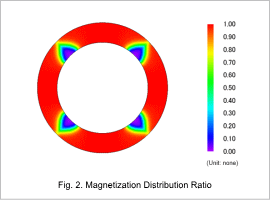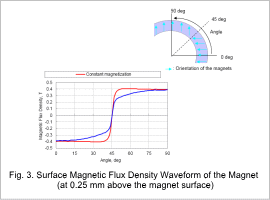*Please prepare a license ID and password for the license administrator.
*It is different from the service for JMAG WEB MEMBER (free membership). Please be careful.
Overview

A surface magnet type motor (SPM) has direct contact with a stator which generates torque through the interaction of magnetic fields generated by magnets and excitation coils. The magnetization state of a magnet is the main factor which determines the characteristics of a motor. It is important that motor designers adjust the magnetization pattern when designing a motor to restrain the higher components of an induced voltage to confirm the variation in characteristics. A general method of confirming the magnetization direction of a magnet is measuring the induced voltage waveform or the surface magnetic flux density of the magnet.
The characteristic such as magnetization device, magnetization of electric current, or magnetizing ration needs to be taken into account when evaluating the magnetic patterns. To evaluate the characteristics in advance, understanding the entire flow of magnetization is necessary, where a magnetic field analysis simulation using the finite element method which can obtain details on electromagnetic behavior from results is very useful.
In this example, carry out SPM motor’s magnetization to obtain the magnetization field and magnet’s surface magnetic flux density.
The characteristic such as magnetization device, magnetization of electric current, or magnetizing ration needs to be taken into account when evaluating the magnetic patterns. To evaluate the characteristics in advance, understanding the entire flow of magnetization is necessary, where a magnetic field analysis simulation using the finite element method which can obtain details on electromagnetic behavior from results is very useful.
In this example, carry out SPM motor’s magnetization to obtain the magnetization field and magnet’s surface magnetic flux density.
Magnetization Field

The magnetization field distribution during a magnetization field evaluation is shown in fig. 1. This figure shows the magnetization field distribution that is obtained by flowing current through the stator coil. The magnetization field between poles is smaller than at the center of the pole. The effective magnetization field distribution is obtained from this magnetization field and the orientation of the magnet.
Magnetization Ratio

Fig. 2 shows the magnetization distribution of the magnet after the magnetization influence from being used in the motor. It can be seen that near the magnetic poles on the outside of the magnet is fully magnetized, but between the poles on the inside of the magnet the magnet is not fully magnetized.
Surface Magnetic Flux Density of the Magnet

Fig. 3 shows the surface magnetic flux density waveform of the magnet when the uniformly magnetized magnet is used and when the magnetization process is taken into account. The orientation direction of a magnet is in parallel direction. The surface magnetic flux density differs substantially between when the uniformly magnetized magnet is used and when magnetization process is taken into account near 45 deg where orientation components of the magnetization field decrease.


